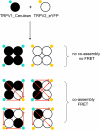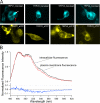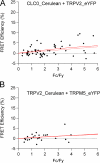Thermosensitive TRPV channel subunits coassemble into heteromeric channels with intermediate conductance and gating properties
- PMID: 17325193
- PMCID: PMC2151614
- DOI: 10.1085/jgp.200709731
Thermosensitive TRPV channel subunits coassemble into heteromeric channels with intermediate conductance and gating properties
Abstract
Heat-sensitive transient receptor potential (TRP) channels (TRPV1-4) form the major cellular sensors for detecting temperature increases. Homomeric channels formed by thermosensitive TRPV subunits exhibit distinct temperature thresholds. While these subunits do share significant sequence similarity, whether they can coassemble into heteromeric channels has been controversial. In the present study we investigated the coassembly of TRPV subunits using both spectroscopy-based fluorescence resonance energy transfer (FRET) and single-channel recordings. Fluorescent protein-tagged TRPV subunits were coexpressed in HEK 293 cells; FRET between different subunits was measured as an indication of the formation of heteromeric channels. We observed strong FRET when fluorescence signals were collected selectively from the plasma membrane using a "spectra FRET" approach but much weaker or no FRET from intracellular fluorescence. In addition, no FRET was detected when TRPV subunits were coexpressed with members of the TRPM subfamily or CLC-0 chloride channel subunits. These results indicate that a substantial fraction of TRP channels in the plasma membrane of cotransfected cells were heteromeric. Single-channel recordings confirmed the existence of multiple heteromeric channel forms. Interestingly, heteromeric TRPV channels exhibit intermediate conductance levels and gating kinetic properties. As these subunits coexpress both in sensory neurons and in other tissues, including heart and brain, coassembly between TRPV subunits may contribute to greater functional diversity.
Figures














Similar articles
-
Homo- and heteromeric assembly of TRPV channel subunits.J Cell Sci. 2005 Mar 1;118(Pt 5):917-28. doi: 10.1242/jcs.01675. Epub 2005 Feb 15. J Cell Sci. 2005. PMID: 15713749
-
Coassembly of Warm Temperature-Sensitive Transient Receptor Potential Vanilloid (TRPV) 3 and TRPV4 Channel Complexes with Distinct Functional Properties.Mol Pharmacol. 2022 Jun;101(6):390-399. doi: 10.1124/molpharm.121.000370. Epub 2022 Mar 31. Mol Pharmacol. 2022. PMID: 35361697
-
Members of the Arabidopsis AtTPK/KCO family form homomeric vacuolar channels in planta.Plant J. 2006 Oct;48(2):296-306. doi: 10.1111/j.1365-313X.2006.02868.x. Epub 2006 Sep 19. Plant J. 2006. PMID: 16984403
-
Thermal gating of TRP ion channels: food for thought?Sci STKE. 2006 Mar 14;2006(326):pe12. doi: 10.1126/stke.3262006pe12. Sci STKE. 2006. PMID: 16537823 Review.
-
ThermoTRP channels as modular proteins with allosteric gating.Cell Calcium. 2007 Oct-Nov;42(4-5):427-38. doi: 10.1016/j.ceca.2007.04.004. Epub 2007 May 17. Cell Calcium. 2007. PMID: 17499848 Review.
Cited by
-
Proton block of proton-activated TRPV1 current.J Gen Physiol. 2015 Aug;146(2):147-59. doi: 10.1085/jgp.201511386. Epub 2015 Jul 13. J Gen Physiol. 2015. PMID: 26170176 Free PMC article.
-
The time course of brief and prolonged topical 8% capsaicin-induced desensitization in healthy volunteers evaluated by quantitative sensory testing and vasomotor imaging.Exp Brain Res. 2018 Aug;236(8):2231-2244. doi: 10.1007/s00221-018-5299-y. Epub 2018 May 29. Exp Brain Res. 2018. PMID: 29845449
-
Channeling satiation: a primer on the role of TRP channels in the control of glutamate release from vagal afferent neurons.Physiol Behav. 2014 Sep;136:179-84. doi: 10.1016/j.physbeh.2014.09.003. Epub 2014 Oct 5. Physiol Behav. 2014. PMID: 25290762 Free PMC article. Review.
-
Plant-derived natural products targeting ion channels for pain.Neurobiol Pain. 2023 Apr 17;13:100128. doi: 10.1016/j.ynpai.2023.100128. eCollection 2023 Jan-Jul. Neurobiol Pain. 2023. PMID: 37151956 Free PMC article. Review.
-
A pain-inducing centipede toxin targets the heat activation machinery of nociceptor TRPV1.Nat Commun. 2015 Sep 30;6:8297. doi: 10.1038/ncomms9297. Nat Commun. 2015. PMID: 26420335 Free PMC article.
References
-
- Ahluwalia, J., H. Rang, and I. Nagy. 2002. The putative role of vanilloid receptor-like protein-1 in mediating high threshold noxious heat-sensitivity in rat cultured primary sensory neurons. Eur. J. Neurosci. 16:1483–1489. - PubMed
-
- Amiri, H., G. Schultz, and M. Schaefer. 2003. FRET-based analysis of TRPC subunit stoichiometry. Cell Calcium. 33:463–470. - PubMed
-
- Arniges, M., J.M. Fernandez-Fernandez, N. Albrecht, M. Schaefer, and M.A. Valverde. 2006. Human TRPV4 channel splice variants revealed a key role of ankyrin domains in multimerization and trafficking. J. Biol. Chem. 281:1580–1586. - PubMed
-
- Bykova, E.A., X.-D. Zhang, T.-Y. Chen, and J. Zheng. 2006. Large movement in the C terminus of CLC-0 chloride channel during slow gating. Nat. Struct. Mol. Biol. 13:1115–1119. - PubMed
-
- Caterina, M.J., and D. Julius. 2001. The vanilloid receptor: a molecular gateway to the pain pathway. Annu. Rev. Neurosci. 24:487–517. - PubMed
Publication types
MeSH terms
Substances
LinkOut - more resources
Full Text Sources
Research Materials
Miscellaneous

